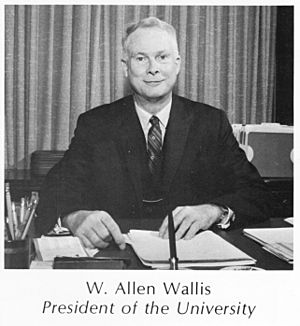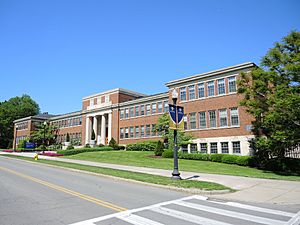W. Allen Wallis facts for kids
Quick facts for kids
W. Allen Wallis
|
|
|---|---|
 |
|
| 2nd Chancellor of the University of Rochester | |
| In office 1970–1982 |
|
| Preceded by | Ira Harris |
| 1st CEO of the University of Rochester | |
| In office 1970–1975 |
|
| Succeeded by | Robert L. Sproull |
| 6th President of the University of Rochester | |
| In office 1962–1970 |
|
| Preceded by | Cornelis W. de Kiewiet |
| Succeeded by | Robert L. Sproull |
| Personal details | |
| Born | November 5, 1912 Philadelphia, Pennsylvania |
| Died | October 12, 1998 (aged 85) Rochester, New York |
| Nationality | American |
| Political party | Independent (until 1984) Republican (1984–1998) |
| Spouse | Anne Armstrong |
| Children | Nancy Wallis Ingling Virginia Wallis Cates |
| Parents | Wilson Dallam Wallis, Grace Steele Allen |
| Alma mater | University of Minnesota, The University of Chicago |
| Profession | Administrator |
Wilson Allen Wallis (born November 5, 1912 – died October 12, 1998) was an American expert in economics and statistics. He led the University of Rochester as its president. He is famous for something called the Kruskal–Wallis test. This test helps people understand data better. It was named after him and William Kruskal.
Early Life and Studies
Wilson Allen Wallis was born in Philadelphia. He went to the University of Minnesota and finished his studies in 1932. He studied psychology there. After that, he went to The University of Chicago in 1933 to study economics.
At Chicago, he became good friends with other smart people. These friends included Milton Friedman, Aaron Director, and George Stigler. They remained friends for their whole lives.
Helping During World War II
From 1936 to 1937, Wallis worked for the government. He used his skills in economics and statistics. During World War II, he led a special research group. This group was part of the U.S. Office of Scientific Research and Development.
He worked at Columbia University from 1942 to 1946. He brought together many bright young economists, including his friends Friedman and Stigler. They helped with important research for the war effort.
Leading Universities
Wallis became a leader in education. From 1956 to 1962, he was the dean of The University of Chicago Graduate School of Business. As dean, he created a new way to teach business. It used statistical methods to solve business problems.
In 1962, he became the president of the University of Rochester. He held this important job until 1970. Then, he became the university's chancellor and chief executive. This meant he was in charge of the whole university.
In 1975, he stopped being the chief executive. But he stayed on as chancellor until he retired in 1982. In 1992, the University of Rochester honored him. They named a special program after him: the W. Allen Wallis Institute of Political Economy. He passed away in 1998 in Rochester, New York.
Advising Presidents
Besides his work at universities, Wallis also advised several U.S. presidents. He helped presidents like Dwight D. Eisenhower, Richard Nixon, Gerald Ford, and Ronald Reagan.
Under President Eisenhower, he worked with Vice President Nixon. They wrote a report about keeping prices stable and helping the economy grow.
For Presidents Nixon and Ford, he served on important groups. These groups looked at government statistics and Social Security. Nixon also made Wallis the chairman of the Corporation for Public Broadcasting. He held this role from 1975 to 1978.
Under President Reagan, Wallis held a high position in the government. He was the Under Secretary of State for Economic Affairs from 1982 to 1985. Later, the job title changed. He became the Under Secretary of State for Economic, Business, and Agricultural Affairs. He served in this role until 1989.
See Also
- Kruskal–Wallis one-way analysis of variance



